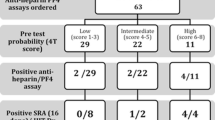Abstract
Diagnosis of heparin induced thrombocytopenia (HIT) is not always easy, especially when a confirmatory functional test is not available. In most cases the diagnosis relies on the combination of pretest probability and an immunologic test. Among patients post cardiopulmonary bypass (CPB) surgery, anti-platelet factor 4/heparin antibodies tend to be high but with low clinical implication. The current retrospective study examined the behavior of patients with positive PF4/heparin-PaGIA results, divided into two groups according to whether or not they have undergone CPB surgery. The main focus of the study was on the reliability of the PF4/heparin-PaGIA test in these two settings. The files of 104 single center patients, who had a positive PF4/heparin-PaGIA test, were reviewed. 62 % were post CPB and 38 % were not. An association between the intensity of positivity of PF4/heparin-PaGIA test and both the 4Ts pretest probability method (p = 0.003) and the incidence of thrombosis (p = 0.02) was found only in the patients who have not undergone CPB surgery, but not in the CPB patients. This study suggests that PF4/heparin-PaGIA is not a reliable method in patients post CPB surgery who are investigated for a possible diagnosis of HIT.


Similar content being viewed by others
References
Lo GK, Juhl D, Warkentin TE, Sigouin CS, Eichler P, Greinacher A (2006) Evaluation of pretest clinical score (4 T’s) for the diagnosis of heparin-induced thrombocytopenia in two clinical settings. J Thromb Haemost 4(4):759–765. doi:10.1111/j.1538-7836.2006.01787.x
Cuker A, Arepally G, Crowther MA, Rice L, Datko F, Hook K, Propert KJ, Kuter DJ, Ortel TL, Konkle BA, Cines DB (2010) The HIT expert probability (HEP) score: a novel pre-test probability model for heparin-induced thrombocytopenia based on broad expert opinion. J Thromb Haemost 8(12):2642–2650. doi:10.1111/j.1538-7836.2010.04059.x
Lillo-Le Louet A, Boutouyrie P, Alhenc-Gelas M, Le Beller C, Gautier I, Aiach M, Lasne D (2004) Diagnostic score for heparin-induced thrombocytopenia after cardiopulmonary bypass. J Thromb Haemost 2(11):1882–1888. doi:10.1111/j.1538-7836.2004.00949.x
Sheridan D, Carter C, Kelton JG (1986) A diagnostic test for heparin-induced thrombocytopenia. Blood 67(1):27–30
Bakchoul T, Giptner A, Najaoui A, Bein G, Santoso S, Sachs UJ (2009) Prospective evaluation of PF4/heparin immunoassays for the diagnosis of heparin-induced thrombocytopenia. J Thromb Haemost 7(8):1260–1265. doi:10.1111/j.1538-7836.2009.03465.x
Warkentin TE, Sheppard JI, Moore JC, Sigouin CS, Kelton JG (2008) Quantitative interpretation of optical density measurements using PF4-dependent enzyme-immunoassays. J Thromb Haemost 6(8):1304–1312. doi:10.1111/j.1538-7836.2008.03025.x
Whitlatch NL, Perry SL, Ortel TL (2008) Anti-heparin/platelet factor 4 antibody optical density values and the confirmatory procedure in the diagnosis of heparin-induced thrombocytopenia. Thromb Haemost 100(4):678–684
Zwicker JI, Uhl L, Huang WY, Shaz BH, Bauer KA (2004) Thrombosis and ELISA optical density values in hospitalized patients with heparin-induced thrombocytopenia. J Thromb Haemost 2(12):2133–2137. doi:10.1111/j.1538-7836.2004.01039.x
Baroletti S, Hurwitz S, Conti NA, Fanikos J, Piazza G, Goldhaber SZ (2012) Thrombosis in suspected heparin-induced thrombocytopenia occurs more often with high antibody levels. Am J Med 125(1):44–49. doi:10.1016/j.amjmed.2011.06.025
Ruf KM, Bensadoun ES, Davis GA, Flynn JD, Lewis DA (2011) A clinical-laboratory algorithm incorporating optical density value to predict heparin-induced thrombocytopenia. Thromb Haemost 105(3):553–559. doi:10.1160/TH10-09-0610
Cuker A, Cines DB (2012) How I treat heparin-induced thrombocytopenia. Blood 119(10):2209–2218. doi:10.1182/blood-2011-11-376293
Meyer O, Salama A, Pittet N, Schwind P (1999) Rapid detection of heparin-induced platelet antibodies with particle gel immunoassay (ID-HPF4). Lancet 354(9189):1525–1526. doi:10.1016/S0140-6736(99)03625-9
Eichler P, Raschke R, Lubenow N, Meyer O, Schwind P, Greinacher A (2002) The new ID-heparin/PF4 antibody test for rapid detection of heparin-induced antibodies in comparison with functional and antigenic assays. Br J Haematol 116(4):887–891
Pouplard C, Gueret P, Fouassier M, Ternisien C, Trossaert M, Regina S, Gruel Y (2007) Prospective evaluation of the ‘4Ts’ score and particle gel immunoassay specific to heparin/PF4 for the diagnosis of heparin-induced thrombocytopenia. J Thromb Haemost 5(7):1373–1379. doi:10.1111/j.1538-7836.2007.02524.x
Nellen V, Sulzer I, Barizzi G, Lammle B, Alberio L (2012) Rapid exclusion or confirmation of heparin-induced thrombocytopenia: a single-center experience with 1,291 patients. Haematologica 97(1):89–97
Selleng S, Malowsky B, Strobel U, Wessel A, Ittermann T, Wollert HG, Warkentin TE, Greinacher A (2010) Early-onset and persisting thrombocytopenia in post-cardiac surgery patients is rarely due to heparin-induced thrombocytopenia, even when antibody tests are positive. J Thromb Haemost 8(1):30–36. doi:10.1111/j.1538-7836.2009.03626.x
Gruel Y, Pouplard C (2010) Post-operative platelet count profile: the most reliable tool for identifying patients with true heparin-induced thrombocypenia after cardiac surgery. J Thromb Haemost 8(1):27–29. doi:10.1111/j.1538-7836.2009.03646.x
Pouplard C, May MA, Iochmann S, Amiral J, Vissac AM, Marchand M, Gruel Y (1999) Antibodies to platelet factor 4-heparin after cardiopulmonary bypass in patients anticoagulated with unfractionated heparin or a low-molecular-weight heparin: clinical implications for heparin-induced thrombocytopenia. Circulation 99(19):2530–2536
Abramson JH (2011) WINPEPI updated: computer programs for epidemiologists, and their teaching potential. Epidemiol Perspect Innov 8(1):1. doi:10.1186/1742-5573-8-1
Visentin GP, Malik M, Cyganiak KA, Aster RH (1996) Patients treated with unfractionated heparin during open heart surgery are at high risk to form antibodies reactive with heparin: platelet factor 4 complexes. J Lab Clin Med 128(4):376–383
Bauer TL, Arepally G, Konkle BA, Mestichelli B, Shapiro SS, Cines DB, Poncz M, McNulty S, Amiral J, Hauck WW, Edie RN, Mannion JD (1997) Prevalence of heparin-associated antibodies without thrombosis in patients undergoing cardiopulmonary bypass surgery. Circulation 95(5):1242–1246
Warkentin TE, Sheppard JA, Horsewood P, Simpson PJ, Moore JC, Kelton JG (2000) Impact of the patient population on the risk for heparin-induced thrombocytopenia. Blood 96(5):1703–1708
Cella G, Vittadello O, Gallucci V, Girolami A (1981) The release of beta-thromboglobulin and platelet factor 4 during extracorporeal circulation for open heart surgery. Eur J Clin Invest 11(3):165–169
Sachais BS, Litvinov RI, Yarovoi SV, Rauova L, Hinds JL, Rux AH, Arepally GM, Poncz M, Cuker A, Weisel JW, Cines DB (2012) Dynamic antibody-binding properties in the pathogenesis of HIT. Blood 120(5):1137–1142. doi:10.1182/blood-2012-01-407262
Warkentin TE, Greinacher A (2003) Heparin-induced thrombocytopenia and cardiac surgery. Ann Thorac Surg 76(6):2121–2131
Author information
Authors and Affiliations
Corresponding author
Rights and permissions
About this article
Cite this article
Ganzel, C., Rowe, J. & Raveh, D. Platelet factor 4/heparin-particle gel immunoassay (PaGIA) is a weak method for heparin-induced thrombocytopenia (HIT) evaluation of post cardio-pulmonary bypass surgery patients. J Thromb Thrombolysis 38, 314–320 (2014). https://doi.org/10.1007/s11239-014-1066-5
Published:
Issue Date:
DOI: https://doi.org/10.1007/s11239-014-1066-5




